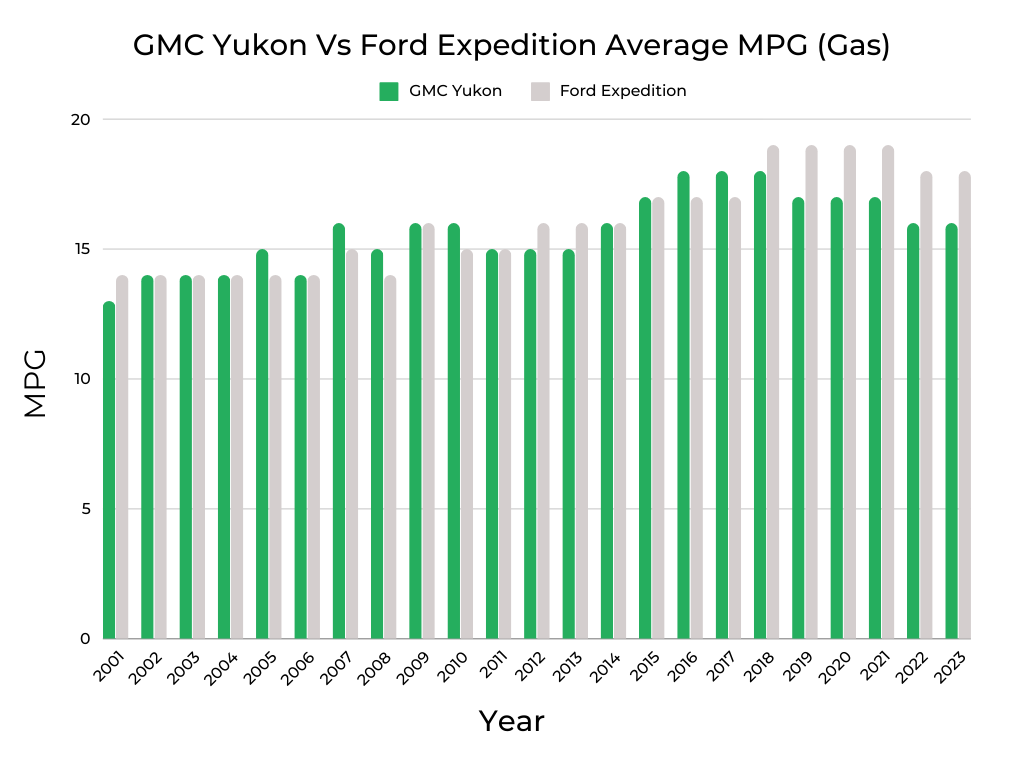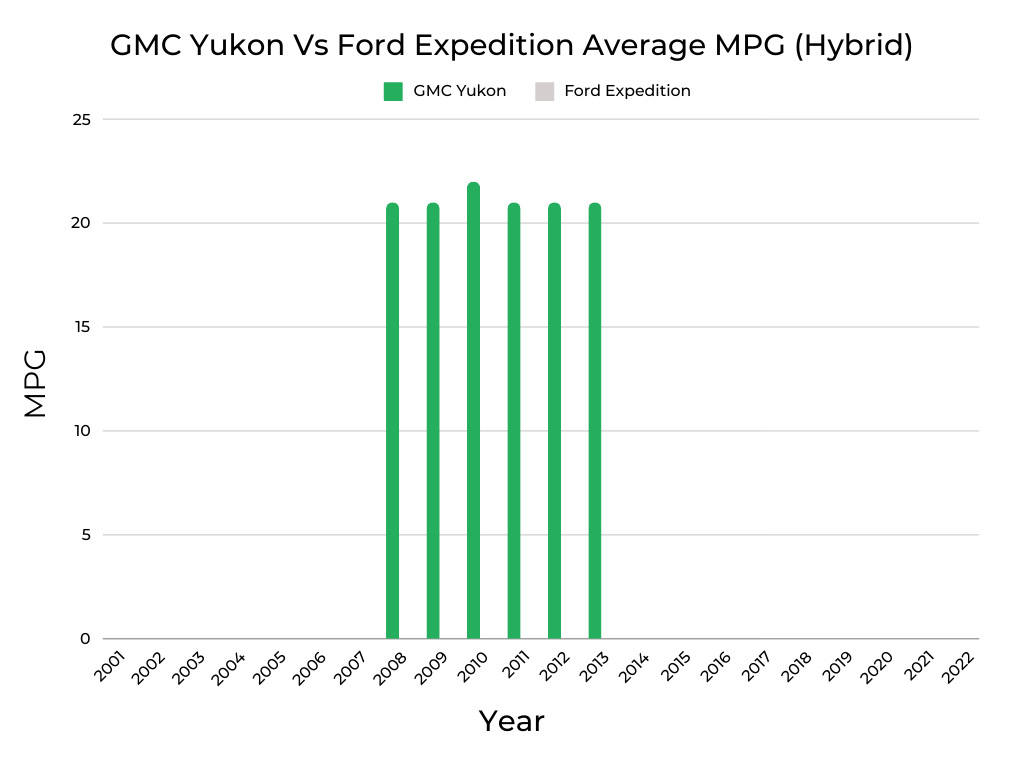Full-sized SUVs like the GMC Yukon and Ford Expedition represent a small percentage of all utility vehicles sold annually. Still, they are essential tools for large families and people who prefer their cars on the bigger side.
While the Yukon and Expedition are overkill for me, I get why they’re the perfect choice for some. I’ve had the opportunity to get behind the wheels of these SUVs as loaners and rentals or for shared driving duties, which opened my eyes to their value. In particular, both vehicles offer third rows that are survivable for adults, something you can’t say with a Toyota Highlander or Honda Pilot. Plus, there’s ample cargo space behind the third row, a feature missing in many three-row crossovers.
Sizing up the Yukon against the Expedition is logical as Ford’s largest SUV offers capabilities similar to the GMC but at generally lower prices. At the same time, the Yukon has a unique role. It’s not as upscale as a Lincoln Navigator (that’s what the Cadillac Escalade is for), but is more premium than a Chevrolet Tahoe.
This slight distinction in market position and greater depreciation for the Expedition means being prepared to spend more for a Yukon. The obvious flip side is that bargain hunters will appreciate the Expedition’s usually lower prices.
This Yukon-Expedition contest is just another GM versus Ford battle that’s been going on for decades. Fans of these automakers may want to explore more examples, like the Ford Mustang versus the Chevrolet Camaro and the Ford Expedition versus the Chevrolet Suburban comparison.
Meanwhile, Blue Oval enthusiasts will be disappointed to learn that the Expedition’s engine reliability isn’t quite up to the standards of the Yukon, particularly among earlier model years. However, maintenance and repairs cost about one-third less with the Expedition.
At the same time, several factors put the GMC Yukon and the Ford Expedition on equal terms. Both vehicles have similar longevity prospects, safety scores, and fuel economy ratings.
Keep reading to see how this GMC Yukon and Ford Expedition contest turns out. You can learn about resale values, depreciation, reliability, longevity, maintenance costs, and fuel economy—essentials to understand to make a more informed car-buying decision.
Other match-ups to review include Tahoe vs Expedition, Suburban vs. Tahoe, Jetta vs. Civic, Sentra vs. Corolla, Outback vs. Forester, 4Runner vs. Highlander, RAV4 vs. CR-V, Civic vs. Corolla, Pilot vs. Highlander, and Odyssey vs. Sienna.
| Income Bracket | Monthly Financing Cost Range | Cash Purchase Price Range | GMC Yukon Years | Ford Expedition Years | Best Model Year: | Why? |
| $5k – $10k | $83 – $125 | $3,000 – $4,500 | 2005 | N/A | 2005 Yukon | Low price |
| $10k – $15k | $125 – $187 | $4,500 – $6,750 | 2009 | 2010 | 2009 Yukon | Good safety score, average engine reliability |
| $15k – $25k | $187 – $312 | $6,750 – $11,250 | 2013 | 2016 | 2016 Expedition | Very good engine reliability, excellent safety score |
| $35k – $50k | $437 – $625 | $15,750 – $22,500 | N/A | 2017 | 2017 Expedition | Excellent engine reliability, excellent safety score |
| $50k – $74k | $625 – $925 | $22,500 – $33,300 | 2019 | 2018 | 2019 Yukon | Excellent engine reliability, very good safety score |
| $75k – $99k | $925 – $1,238 | $33,300 – $44,550 | N/A | 2019 | 2019 Expedition | Very good engine reliability, excellent safety score |
| $100k – $150k | $1,238 – $2,250 | $44,550 – $67,500 | N/A | 2021 | 2021 Expedition | Top engine reliability, excellent safety score |
See the methodology for the table above.
Curious about other car pairings? Check these articles to explore:
Volkswagen Jetta vs. Honda Civic
Before you respond to the “For Sale” ad, check out this How to Buy a Used Car article for a step-by-step checklist.
Price History Comparison | GMC Yukon vs. Ford Expedition
Average Market Value – Based on Owners’ Self-Reported Mileages | GMC Yukon vs. Ford Expedition
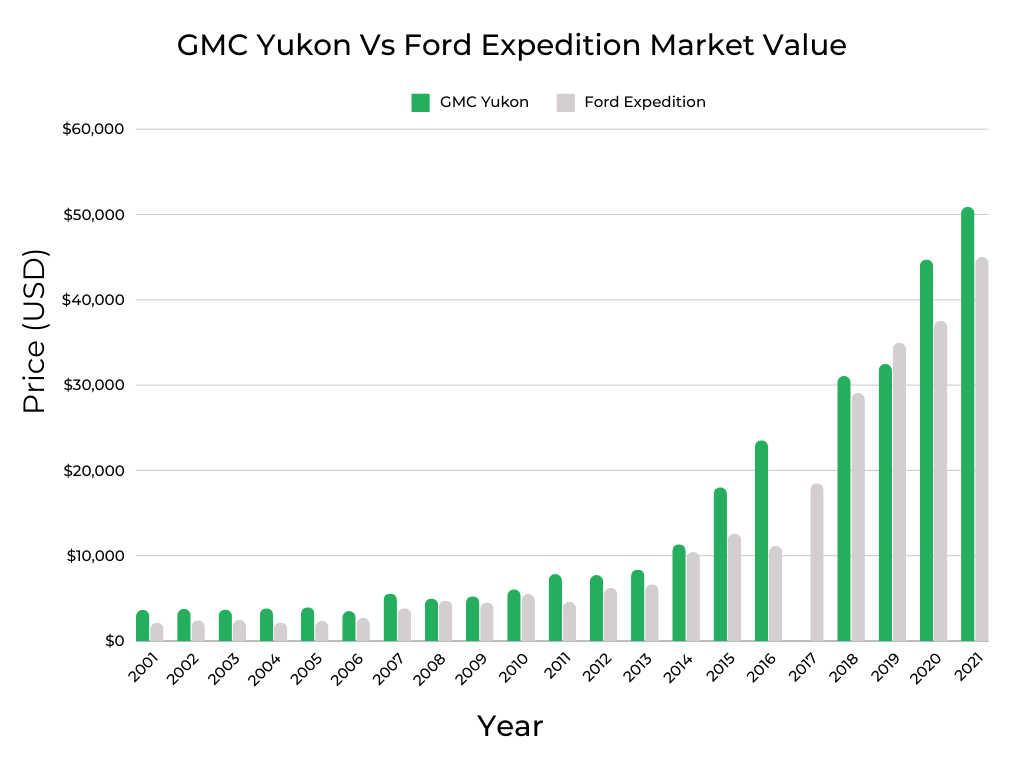
A look at private-party sales data from Kelley Blue Book (KBB) shows that the GMC Yukon (green) typically has higher average market values than the Ford Expedition (gray). Some of the differences are due to owner-reported mileage (from FIXD surveys) being incorporated into the numbers, which makes the prices more reflective of real-world conditions.
Two other factors help explain why you’ll spend less for an Expedition and an equivalent Yukon: starting prices and depreciation.
In 2007, a base Yukon SLE stickered at $34,690, while an Expedition XLT cost $32,895. The $1,800 difference isn’t huge, but it impacts selling prices when these vehicles hit the market as used cars. There are similar gaps in the later years. For example, a 2013 Yukon SLE sold for $43,315 compared to a same-year Expedition XLT at $41,600. In 2018, the Yukon SLE started at $53,395 versus $52,985 for the Expedition XLT.
The Expedition’s slightly higher depreciation amplifies the separation. Today, that 2008 Yukon sells for $4,583 against $3,854 for a 2008 Expedition. Of course, depreciation has been less severe among more recent model years. What’s a used 2018 Yukon or Expedition going for these days? On average, $31,078 is spent on the GMC and $29,078 on the Ford.
Nonetheless, the loss of value hits the Expedition harder than the Yukon. CarEdge forecasts that a new Yukon loses 35% of its value over five years, compared to 37% for the Expedition. That 2% disparity isn’t significant, but combined with higher original MSRPs for the Yukons, it makes the Expeditions less expensive. This is an essential element for bottom-line shoppers to recognize.
It’s also vital to know that KBB prices in the chart come from private-party transactions—you’ll pay 30% to 50% more at a dealer. Targeting older models or ones with more mileage is an effective way of offsetting retail prices.
Be sure to read our Best and Worst Years series of articles highlighting the GMC Yukon and Ford Expedition winners and losers.
Depreciation vs. Maintenance Expenses
Like savvy investors who “buy the dip” in the stock market, smart used car shoppers look for vehicles that have significantly dropped in price and still cost less to maintain. That’s the secret to getting a great deal on a used car.
The Yukon’s target window, 2002 to 2013, is broad, creating numerous buying opportunities. In particular, 2002 to 2005 bring together very low upkeep costs and bottomed-out residual values. Examples from 2011 to 2013 also have especially low repair tabs and still reasonable market values.
Expedition buyers will find a similar range from 2003 to 2014. Yes, the earlier years (2004 to 2007) have a history of higher maintenance costs, but the market values are low. Expeditions from 2008 to 2014 are the sweet spot: low purchase costs and modest upkeep expenses.
But don’t assume every example within these ranges is a smart buy. Learn more by reviewing the best and worst years of the GMC Yukon and Ford Expedition. There’s also an at-a-glance summary towards the end of this article.
Reliability Comparison | GMC Yukon vs Ford Expedition
Two ratings are at the core of our look at the GMC Yukon and Ford Expedition.
- The FIXD Reliability Score measures the number of check engine lights recorded for a particular model year by installed FIXD sensors. Think of it as an engine reliability score. While every check engine light doesn’t directly translate into reliability concerns (such as a dead battery or loose gas cap), these indicators still provide insight into a car’s dependability. This data is weighted by mileage.
- The second rating is the Owner Reliability Score. This is a subjective ranking of how surveyed owners feel about their respective vehicle’s dependability. Each owner estimates how capable their car is for trips of different lengths. A vehicle that can handle a cross-country adventure receives the highest score, while a car only suitable for a quick point A to point B trip gets the lowest score.
Both rankings are based on 1 being the lowest, 10 being the highest, and 5 being the average score.
We’ll also point out that both scores seldom align. The FIXD Reliability Score is determined by a definitive number, the frequency of check engine lights. On the other hand, the Owner Reliability Score is opinion-based. Owners tend to have pride in their automobiles, with higher ratings as a result. At a minimum, those with older vehicles are more accepting of check engine lights. For many, it’s the price of owning an aging car.
When examining dependability, dividing the field of 21st-century Yukons and Expeditions into two groups makes sense. Examples from 2001-2009 are far from perfect. To be fair, this applies to most vehicles with 20 years, give or take, of use.
But compared to aged Yukons, the equivalent Expeditions have far worse engine reliability. Among these nine model years, the Yukon had a higher FIXD Reliability Score for seven. There was a tie for the other two years. The Expedition never came out ahead during this period. In fact, while some Yukon years achieved a mediocre score of 5, these Expeditions never went above 2.
The results for newer Yukons and Expeditions from 2010 to 2021 are a mix of good and bad news, depending on your point of view. Among these 12 years, the Yukon had higher engine reliability scores for seven, compared to one for the Expedition. There was a tie for four years.
From an overall perspective, these newer SUVs had higher FIXD Reliability Scores. The vast majority had ratings of 8 or better. However, a few Yukon model years dipped to a 6 or 7. The Expedition had its share of laggards but with scores that dropped to as low as 4.
In short, GMC Yukon owners see fewer check engine lights than those with a Ford Expedition in the driveway.
Yet, real-world experiences don’t diminish Expedition owners’ fondness for their vehicles. Except for the 2018 editions, these Fords mostly rank equal to or better than the Yukon when it comes to Owner Reliability Scores.
Review the Best and Worst Years articles on the GMC Yukon and Ford Expedition to learn more about these vehicles’ FIXD Reliability and Owner Reliability Scores.
Longevity Comparison | GMC Yukon vs. Ford Expedition
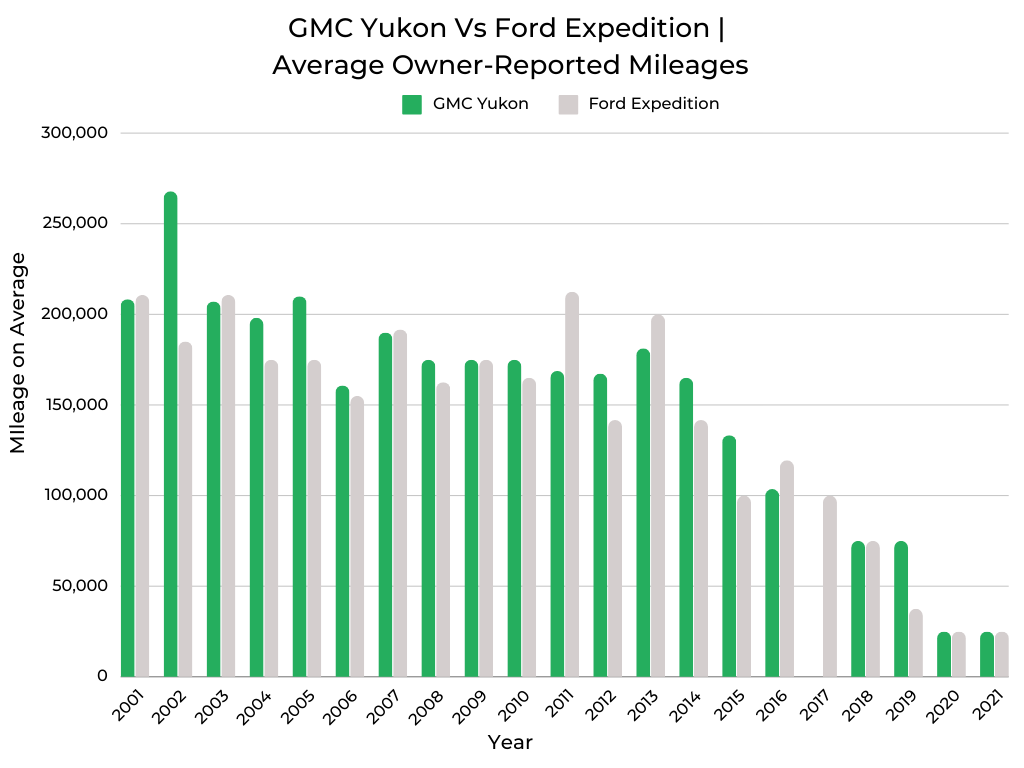
Given the truck-based underpinnings of the Yukon and Expedition, it’s unsurprising that owners report (via FIXD surveys) reaching 150,000 miles or more. As the data shows, 200,000 miles is achievable, with the 2002 Yukon getting top-of-its-class status (over 250,000 miles). All this feedback points to the Yukon and Expedition having similar longevity prospects, but let’s look elsewhere to confirm this assumption.
Autotrader.com listings from April 23, 2024, reveal 426 Yukons and 359 Expeditions for sale from the 2001 to 2012 model years (years that typically have higher mileage). Among these examples, 170 (39.9%) Yukons have 150,000 to 200,000 miles, compared to 136 (37.9%) Expeditions in the same mileage range. The percentages aren’t a match but are close to enough to confidently say both vehicles have the same chance of reaching 200,000 miles.
Sometimes, distinctions in vehicle lifespans occur when looking beyond 200,000 miles. But this isn’t the case with a Yukon-Expedition match-up. At this range—200,000 miles or more—110 (25.8%) Yukons and 80 (22.3%) Expeditions are among the Autotrader listings.
Obviously, these results don’t guarantee the longevity of a Yukon or Expedition, but they underscore that each vehicle has similar odds of racking up the miles. But there’s more to keeping these SUVs on the road than build quality: regular maintenance and good driving habits also matter.
For a more thorough look at longevity, review the individual articles on the best and worst years of the GMC Yukon and Ford Expedition.
Who Should Buy These Cars: The Legacy of GMC Yukon vs. Ford Expedition
Functionality is another area where the Yukon and Expedition closely align. Via FIXD surveys, owners reported using these vehicles at nearly identical rates for the same tasks. Above all else, these are family vehicles, which is confirmed by FIXD surveys showing that 46% of Yukon owners and 43% of Expedition owners are involved in transporting loved ones.
These vehicles are also well used for “lots of driving,” which groups commuting and road-tripping together. This activity involves 23% of Yukon owners, compared to 20% of Expedition owners.
Large engines and robust frames make these SUVs well-suited for hauling and towing, a capability taken advantage of by about one in six Yukon and Expedition. Despite the rugged nature of the Yukon and Expedition, including available four-wheel drive, few owners head off the pavement, with only 7% of owners reporting using their Yukons and Expeditions for outdoor and off-road activities.
| Frequent Use Categories: |
GMC Yukon | How Useful? (Out of 5 Stars) |
Ford Expedition | How Useful? (Out of 5 Stars) |
| Family Vehicle | **** | **** |
| Lots of Driving (travel/long commute) | *** | *** |
| Hauling/Towing | ** | ** |
| Office on Wheels | * | * |
| Sport/Fast Driving | * | * |
| Luxurious Driving | * | * |
| Outdoor/Off-Road | * | * |
Driver Experience | A Summary of The Top 10 GMC Yukon vs Ford Expedition Posts:
Yukon and Expedition shoppers will find many opinions about these SUVs on Reddit. Here are some key points from popular Reddit: r/whatcarshouldIbuy posts.
Performance and Reliability
Many Reddit discussions revolve around the performance and reliability of the GMC Yukon and Ford Expedition. Commenters note that while newer Yukon and Expeditions share a 10-speed automatic transmission, the Expedition’s 3.5L Ecoboost V6 is noted for its strong performance and fuel efficiency despite its size. The Yukon, meanwhile, is often criticized for the less efficient V8 engines and cumbersome third-row access. One Redditor mentioned reliability concerns with both models, highlighting ongoing issues with older models of both SUVs that might indicate potential long-term problems.
Comfort and Functionality
Regarding comfort, the Ford Expedition often receives praise for its spacious interior and user-friendly third-row access. One commenter highlighted that the Expedition’s seats provide good support for long drives, contrasting with some feedback on the Yukon, where seat comfort was an issue for taller individuals. Functionality discussions often focus on features like rear seat entertainment systems, where preferences split; some users prefer the Yukon’s system while others lean towards the Expedition for its advanced tech features.
Value and Resale
Regarding value for money and resale prospects, the GMC Yukon generally has the edge in the resale value, as noted in discussions. Users point out that while the Expedition might offer a lower initial cost and comparable features, the Yukon maintains its value better over time, making it a potentially smarter purchase for long-term investment. This perspective is reinforced by users who have experience with both brands and suggest that GMC vehicles tend to depreciate less rapidly than their Ford counterparts.
Reddit Recap
Reddit users comparing the GMC Yukon and Ford Expedition highlight several key points. The Expedition is often favored for its powerful and efficient engine, spacious interior, and ease of third-row access. The Yukon, while criticized for its less efficient V8 engines and cumbersome third-row seating, is preferred for its higher resale value and sometimes its tech features. Both models face scrutiny over long-term reliability, with past models showing significant issues that could influence a buyer’s decision.
Year-by-Year Comparison | GMC Yukon vs. Ford Expedition
Best & Worst Years | GMC Yukon vs. Ford Expedition| 2001-2024

Shoppers looking for an inexpensive full-size SUV have only one choice: the 2005 GMC Yukon. The sole option in this age range gets a thumbs up. However, those with a modestly larger budget can go for something newer: a 2009 Yukon or a 2009 or 2010 Ford Expedition.
Due to high repair costs, engine reliability concerns, and other issues, buyers must skip several Yukon years until locating examples from 2013. Yukons from 2014 and 2017 to 2019 also get green lights.
For similar reasons, it’s best to avoid Expeditions from 2011 to 2014 and 2020 and instead target models from 2015 to 2019 and 2021.
I’ll call attention to the undecided years (yellow) only because there isn’t enough information to give these editions a thumbs up or down.
Important Features Timeline | GMC Yukon vs. Ford Expedition
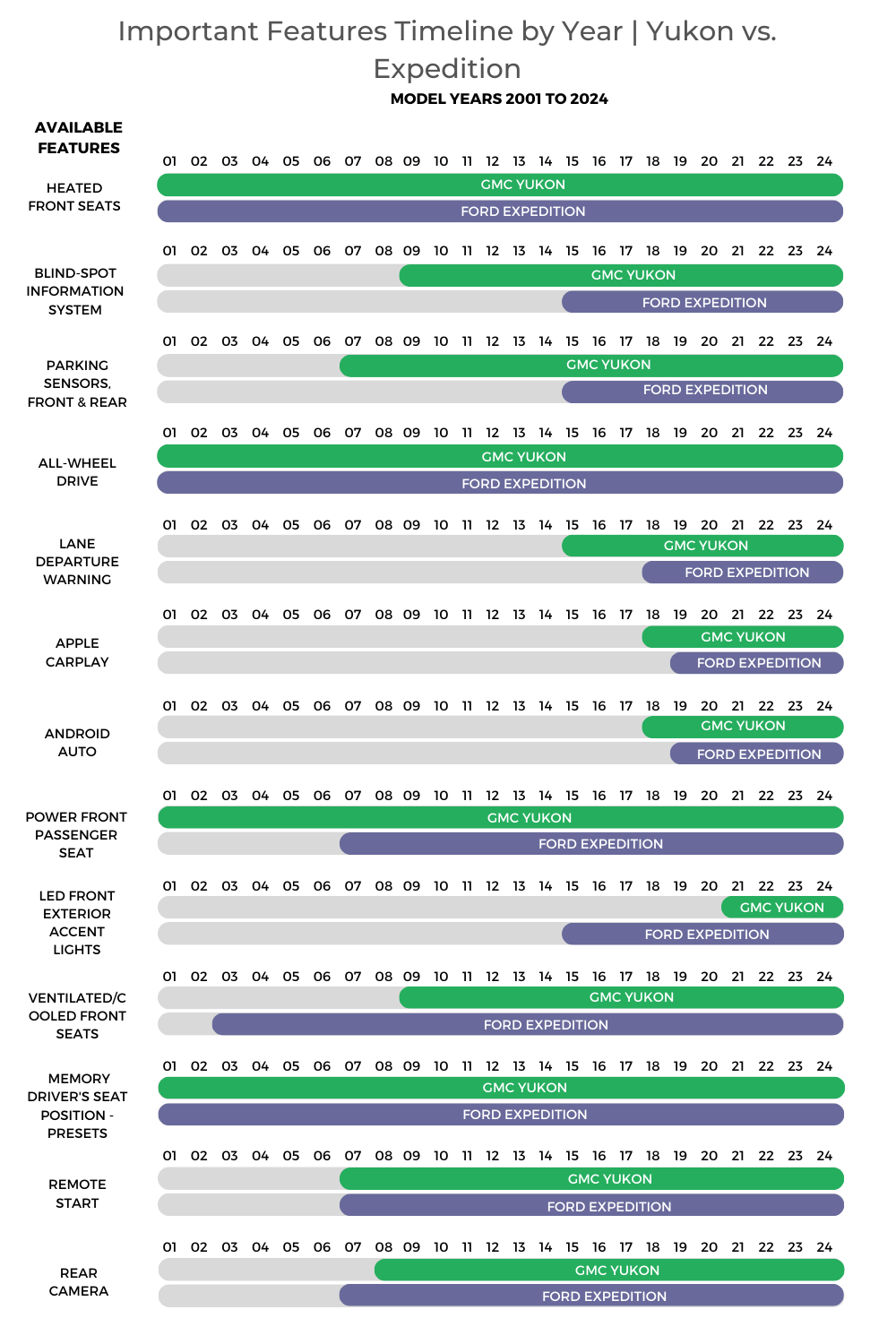
Choosing between a Yukon and an Expedition may come down to equipment. A safety-focused buyer will find the Yukon’s first-mover status with specific advanced driver aids appealing. This GMC received blind-spot monitoring, lane departure warning, and parking sensors years before the Expedition. Ford did give the Expedition a rearview monitor one year before the Yukon.
The Yukon can claim to be first with some comfort and convenience features, like a power front passenger seat, Apple CarPlay, and Android Auto. However, the Expedition did get ventilated front seats before its GMC rival.
If you’re wondering about the Chevrolet Tahoe, the Yukon’s corporate twin, having the same feature rollout schedule, guess again. The Yukon actually came with parking sensors, a power front passenger seat, Apple CarPlay, and Android Auto before the Tahoe. You can learn more in this Chevrolet Tahoe versus GMC Yukon comparison.
Maintenance Costs (Year-by-Year Average) | GMC Yukon vs. Ford Expedition

With larger vehicles come increased upkeep costs. SUVs like the Yukon and Expedition require larger tires, consume more fluids (such as engine oil and coolant), and undergo more rigorous use (which means parts wear out sooner). It all adds to pricey repair bills, with the Yukon being the worst offender of this duo.
FIXD surveys show that the average Yukon owner spent $971 in 2022 to keep their vehicle in operating condition. In contrast, the typical Expedition owner shelled out $666, about a third less. At $852 in annual spending, even a Tahoe is cheaper than a Yukon.
To make matters worse, some Yukons are particularly expensive to own. The 2001, 2006, 2009, 2011, and 2021 model years had maintenance and repair costs that exceeded the $971 average by 20% or more.
However, the Expedition isn’t entirely blameless. Owners of the 2002, 2004, 2007, 2008, and 2020 model years paid at least 20% above average to keep their SUVs on the road.
Review the best and worst years of the GMC Yukon and Ford Expedition to learn more about maintenance and repair costs for these vehicles.
Safety Rating Comparison | GMC Yukon vs. Ford Expedition
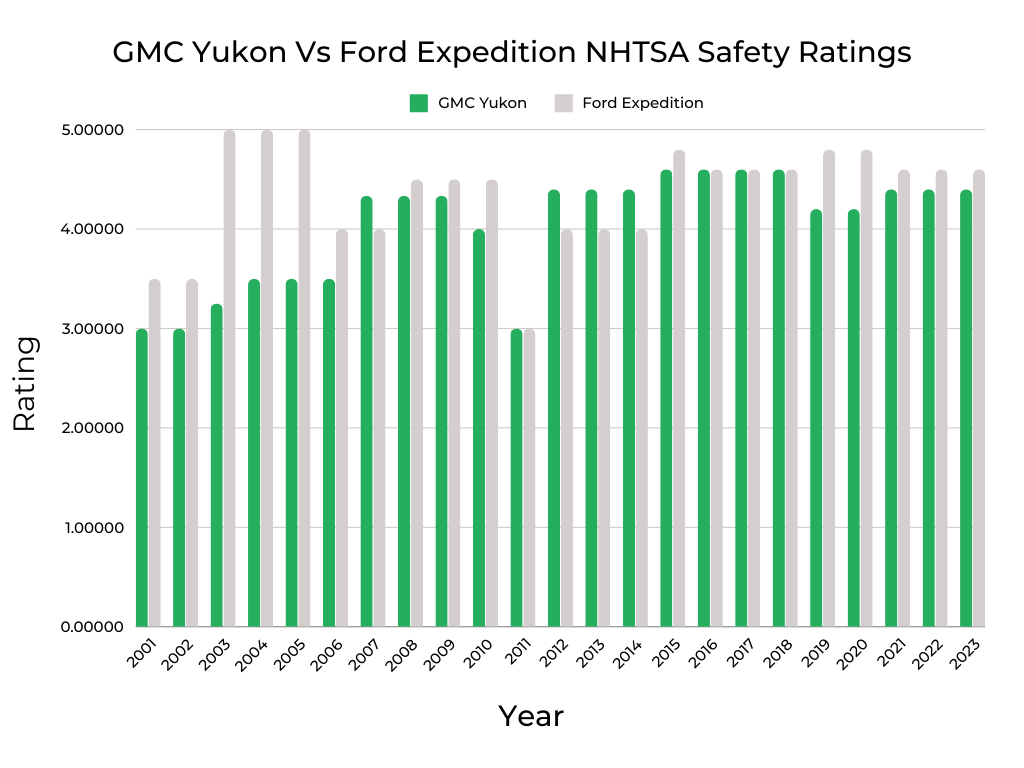
Based on an overall safety score of 4.0 out of 5, most Yukon and Expedition model years perform well in testing by the National Highway Traffic Safety Administration (NHTSA). The only area of concern is older Yukons from 2001 to 2006. However, this was solved with the arrival of the third generation for 2007. I’ll explain what happened in 2011 in a moment.
Outside of the Yukon’s early “problem years” and 2011, both vehicles provide good to great safety performance. So, shoppers of newer editions can be at ease about protecting occupants.
However, the 2011 test results added a twist. This was the year NHTSA introduced more rigorous evaluation standards, causing many models to underperform in the government’s new reviews. By the old standards, the 2001 Yukon and Expedition are likely to have received strong scores (like 2010). Add in the new requirements, and these SUVs deliver bottom-of-the-barrel results. GM and Ford engineers got to work, bringing the Yukon and Expedition into “good” territory for 2012.
More details about crash test safety scores are covered in the GMC Yukon and Ford Expedition articles.
Fuel Efficiency Comparison | GMC Yukon vs. Ford Expedition
Poor fuel economy is a pain point for every owner of a large SUV; getting 15-20 MPG is the reality, regardless of whether you drive a Yukon or Expedition. Both automakers made changes under the hood in the middle of the last decade to help. However, engine tweaking for the Yukon and replacing the Expedition’s V8 with a twin-turbo V6 only go so far. Frequent trips to the pump are the price for a three-row vehicle with generous space throughout.
General Motors made a valiant effort with a Yukon Hybrid (and Tahoe Hybrid) for the 2008 to 2013 model years, but the slight increase over 20 MPG wasn’t enough to entice buyers. The extra cost of and skepticism about hybrid technology (times change!) helped seal the fate of the SUVs.
Methodology
- Compare two vehicles, the GMC Yukon and Ford Expedition, and provide a comprehensive analysis.
- Gather relevant information and data on both vehicles from reliable sources, such as manufacturer specifications, expert reviews, customer feedback, industry reports, and data sources like manufacturer websites, FIXD App, Kelley Blue Book, FuelEconomy.gov, and NHTSA.
- Collect data on various aspects, including performance, safety features, fuel efficiency, maintenance costs, reliability, owner satisfaction, and market value.
- Identify the key criteria that will be used to evaluate and compare the two vehicles.
- Ensure the criteria cover both objective factors (such as performance metrics, safety ratings, and fuel efficiency) and subjective factors (such as owner satisfaction, comfort, and features).
- Examine the safety features and ratings of both vehicles.
- Evaluate crash test ratings, advanced driver assistance systems (ADAS), active and passive safety features, and any notable recalls or known issues related to safety.
- Consider both NHTSA safety ratings and IIHS awards for a comprehensive safety assessment.
- Analyze the fuel economy of both vehicles based on EPA mileage estimates.
- Compare their MPG ratings, average full-tank range, and any significant differences in fuel efficiency.
- Assess the average annual maintenance and repair costs for both vehicles.
- Consider data from surveyed owners and other reliable sources, such as FIXD App owner surveys, to determine the overall cost of ownership over time.
- Evaluate the reliability of both vehicles based on owner reports, FIXD App data, and any known issues or recalls.
- Consider factors such as engine reliability, common problems by model year, long-term durability, and owner reliability scores gathered from surveys.
- Consider owner satisfaction by gathering information from forums, online communities (Reddit: r/whatcarshouldIbuy), customer reviews, and owner reliability scores.
- Summarize key factors that owners appreciate and any common complaints or drawbacks mentioned by owners.
- Compare the features and technologies offered by both vehicles.
- Highlight any notable differences in terms of infotainment systems, connectivity options, driver assistance features, interior quality, and available upgrades.
- Assess the market value and depreciation of both vehicles.
- Compare average prices, resale value, and how the vehicles hold their value over time.
- Consider average private-seller valuations from Kelley Blue Book (KBB) for a comprehensive assessment.
- Summarize the findings of the comparison, highlighting the positives and negatives of each vehicle.
- Provide a fair and balanced recommendation based on the comparison, considering factors such as budget, personal preferences, specific needs of the buyer, and the comprehensive analysis conducted.
Sources:
- KBB Values: Average private-seller valuations as supplied by Kelley Blue Book (KBB), based on a GMC Yukon and Ford Expedition with typical mileage for that respective model year.
- Fuel Economy: Mileage-per-gallon estimates according to the EPA MPG on Fueleconomy.gov.
- Annual Maintenance/Repairs: Upkeep expenses as reported by surveyed GMC Yukon and Ford Expedition owners.
- Safety Ratings: Crash test data collected and reported by NHTSA. We average all ratings for each year to come up with a simplified, average safety score. This makes it easier to look at on a graph. We also collected IIHS Awards for this article.

Dave Goldberg is an automotive journalist and lifelong car fanatic. He writes for numerous enthusiast and business outlets and is an ongoing contributor to HotCars.com, one of the most popular car culture websites. When he’s not writing or driving, Dave is either under a hood or asleep. His credentials include a BA in Journalism from The George Washington University.


